mobile View, to the German Version tap the flag


- Autonomous Republic of Mari El
- federal component of the Russian Federation (Russia)
- other names: Mari Ar, Mariy El
• Flag
• Historical Flags
• Meaning/Origin of the Flag
• Coat of Arms
• Meaning/Origin of the Coat of Arms
• Map
• Numbers and Facts
• History
• Origin of the Country's Name
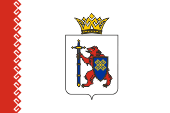
since 2011,
National flag,
ratio = 2:3,
Source, by: Wikipedia (RU)




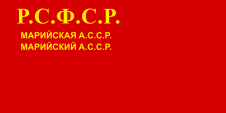
1937–1954,
Flag of the Autonomous Soviet Republic,
ratio = 1:2,
Source, by: World Statesmen



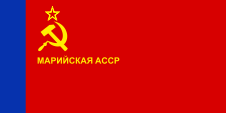
1954–1978,
Flag of the Autonomous Soviet Republic,
ratio = 1:2,
Source, by:
World Statesmen



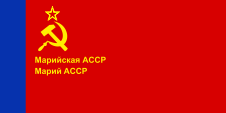
1978–1992,
Flag of the Autonomous Soviet Republic,
ratio = 1:2,
Source, by:
World Statesmen



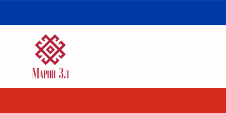
1992–2006,
National flag,
ratio = 1:2,
Source, by:
Flaggen Enzyklopädie



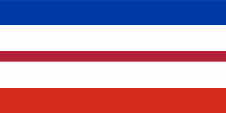
ca. 1992,
National flag,
Variante,
ratio = 1:2,
Source, by: UNPO



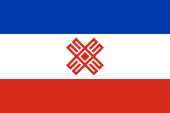
2006–2011,
National flag,
ratio = 2:3,
Source, by:
Flags of the World



look also:
Flag history of the soviet republics of the USSR

The today's flag of Mari El was introduced on 1st of June in 2011. It shows a white bunting with a by a folkloric pattern separated red stripe on the leech. In the middle of the white stripe appears the emblem of the country, a golden crowned, silvery shield with a red bear in the middle, holding a sword in his right paw. The bear carrys a blue, golden bordered shield, which shows in the center the national symbol in gold. This sun sign was already to see on the until 2011 valid flag, but in red. The until 2011 valid blue-white-red flag showed the the colours of Russia, to which Mari El belongs. There had been known some other versions of the flag. The flags, which were used in the Soviet era corresponded all to the same pattern as it was intended for the Soviet Autonomous Republics: Between 1923 and 1937 frequently only a single-coloured red bunting with a golden inscription, showing the name of the country. Sometimes only as a shortcut, sometimes the full name, sometimes only in Russian or even multilingual. From about 1937 hammer, sickle and star were sometimes added. From about the mid-50s multicolored flags were introduced for the republics of the Soviet Union, whose knitting patterns had to be taken over by the subordinated autonomous Soviet republics.
Source: Volker Preuß,
Flaggen Enzyklopädie,
Wikipedia (RU)


Coat of arms of Mari El,
Source:
Wikipedia (DE)

The todays's coat of arms of Mari El was – as the flag – introduced on 1st of June in 2011. It shows a golden crowned, silvery shield with a red bear in the middle, holding a sword in its right paw. The bear carrys a blue, golden bordered shield, which shows a golden sun sign in gold, the national symbol, in the center.
Source:
Wikipedia (RU)

Geographical position within Russia:
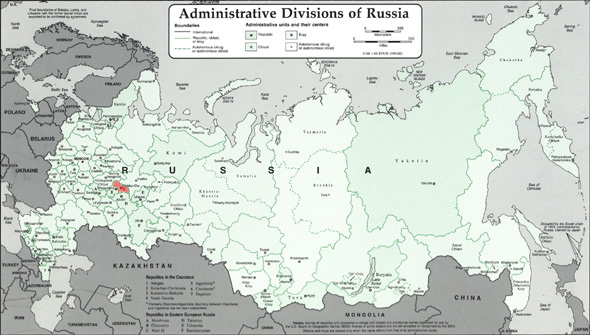
Source: Freeware, russiamap.org, modyfied by: Volker Preuß
enlarge – click or tap here
Map of the country:
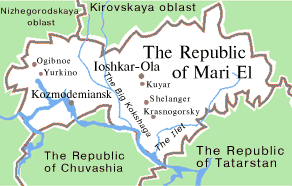
Source: Russiatrek

Area: 9.025 square miles
Inhabitants: 696.459 (2010), thereof 45% Russians, 41% Mari (russ: Cheremissians), 5% Tatars, 1% Chuvash
Density of Population: 12 inh./sq.mi.
Capital: Joschkar-Ola, (former names: to 1919 Zarewokokschajsk, 1919–1927 Krasnokokschajsk), 248.800 inh. (2010)
official Languages: Russian, Mari (Volga Finnish)
other Languages: Tataryan
Currency: Russian currency
Time Zone: since 28th of March 2010, GMT + 3 h; to 28th of March 2010, GMT + 4 h
Source: Russiatrek,
Die Völker der Erde,
Wikipedia (D)

9th cent. · the Mari, a Hinno-Hungrian nation, come under the supremacy of the Volga Bulgarians
14th cent. · the Mari come under the supremacy of the Tatar's Khanate of Kasan
1552 · smashing of the Tatar's Khanate of Kasan, the Mari come under Russian supremacy
18th cent. · beginning strong influence of the Russian culture and language
1920 · establishment of the Autonomous Region of Mari
1936 · elevation to Autonomous Socialistic Mari Republic
1990 · the supreme council of the Mari declares the sovereignty of the republic
31st of December in 1991 · the Soviet Union dissolves, the constitution of the Russian Socialist Federative Soviet Republic (RSFSR, Russia), a former substate of the Soviet Union, remains in force for the time being
25th of December in 1993 · a new constitution for Russia (Russian Federation) comes into force, and the relationships with the members of the federation is re-regulated in this way
1997 · elections, thereafter even stronger influence of the Russian culture and language
Source:
Atlas zur Geschichte,
World Statesmen,
Russiatrek,
Die Völker der Erde,
Wikipedia (D),
Discovery '97

The name of the country goes back to the Mari people who living here, a Finno-Ugric people formerly called Cheremis (Cheremisa or Cheremis people). "Mari El" means literally translated "Land of the Mari".
Source: Wikipedia (D)

Surftipp:


![]()














